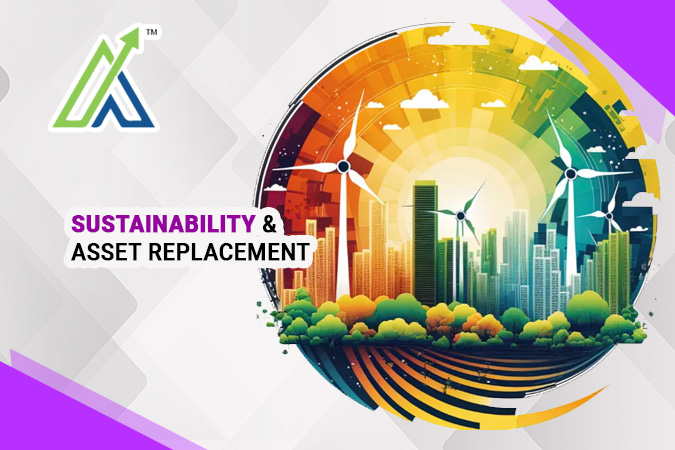In today’s world, sustainability is shaking up asset replacement decisions. Especially in India’s financial system, where environmental, social, and governance (ESG) factors are changing the game. It’s not just about saving the planet—sustainability means big money and long-term gains. Let’s dive into how sustainability fits into asset replacement decisions in India with some real-world examples.
What is Asset Replacement?
Asset replacement is all about ditching old stuff and getting new, better stuff. This keeps everything running smoothly, safely, and efficiently. In the past, it was all about cost, performance, and tech. Now, sustainability is the new boss.
Sustainability in Asset Replacement
Let’s explore the concept of sustainability in asset replacement by considering the following points:
- Cutting Environmental Impact
Sustainability means thinking about how assets affect the environment. For example, swapping old machinery for energy-efficient models cuts carbon emissions and energy use. Picture an Indian factory switching from coal-fired boilers to natural gas ones. Boom—less pollution, cleaner air. - Saving Money Long-term
Sustainable assets can save a lot of money over time. Sure, energy-efficient equipment might cost more at first, but it’s cheaper to run. Think about an Indian textile mill replacing old lights with LEDs. Huge energy savings, smaller bills. - Following the Rules
India’s environmental laws are getting tougher. Companies need to keep up to avoid fines and stay in business. Going sustainable helps them stay ahead. Imagine an Indian car manufacturer upgrading its production line to meet new emission standards. No fines, better reputation. - Boosting Corporate Image
Companies that go green look good to investors, customers, and employees. This can mean more loyal customers and easier access to funds. Picture an Indian FMCG company switching from plastic to biodegradable packaging. Better brand image, more eco-conscious customers.
Challenges and Solutions
Going green isn’t always easy. Here are some bumps in the road and how to smooth them out:
- High Upfront Costs
Sustainable assets can be pricey at first. Companies can look into green bonds or government subsidies. For example, an Indian SME might use a government grant to swap diesel generators for solar panels. - Tech Uncertainty
With tech changing fast, picking the right sustainable assets is tricky. Companies need to do their homework and talk to experts. An Indian IT firm might consult sustainability pros before upgrading data centers to make sure they’re on the right track. - Resistance to Change
Shifting to a green strategy can face pushback. Leaders need to build a culture that values sustainability and explain the benefits clearly. An Indian conglomerate could run training sessions to show employees why going green is smart.
Questions to understand your ability
Qus: What’s the main goal of asset replacement when we talk about sustainability?
- Boosting production speed
- Cutting down environmental harm
- Reducing initial expenses
- Adding more product options
Qus: Why might companies resist shifting to sustainable asset replacement?
- No support from the government
- Pushback from employees
- Not enough customer demand
- Too many regulatory hurdles
Qus: Which is an example of lowering environmental impact through asset replacement?
- Switching from gas boilers to coal-fired ones
- Replacing old lights with LEDs
- Upgrading to pricier, similar machinery
- Using more plastic packaging
Qus: What’s a common financial challenge of going for sustainable assets?
- Lower running costs
- High upfront expenses
- Faster production times
- Easier compliance with laws
Qus: How can companies handle the high initial costs of sustainable assets?
- Ignoring green goals
- Cutting overall production
- Using green bonds or government aid
- Slashing employee salaries
Conclusion
Firms in the financial system in India are required to make sustainability a core aspect of replacement assets. The aim is the minimum negative impact on the environment, short- and long-term costs’ optimization, adherence to the regulations and procedures, and a better overall reputation. The measures in this plan enable entrepreneurship to develop in ways that are universally beneficial for society. However, the same effort in re-buying assets in a manner that is beneficial to the environment is about trying to make the world a better place for everyone to own their own business and stay sustainable.
FAQ's
Swapping out old gear for new, better stuff to keep things running smooth, safe, and efficient.
It cuts down on environmental harm, saves money over time, meets regulations, and boosts company image.
Yeah, like an Indian factory switching from coal to natural gas boilers, cutting pollution and cleaning the air.
Sure, it might cost more upfront, but it saves cash in the long run, like with energy savings from LEDs.
High initial costs, tech uncertainty, and resistance to change.
They look into green bonds or government subsidies to ease the financial load.
Employees might not want to change, and new tech can seem complicated and expensive.
It makes the company look good to investors, customers, and employees, leading to loyal customers and better funding options.

